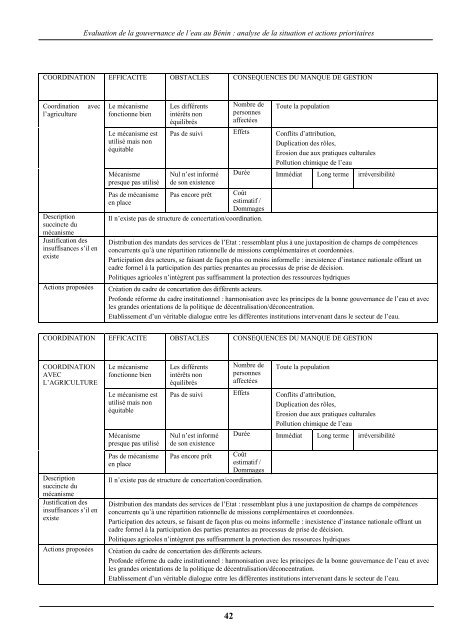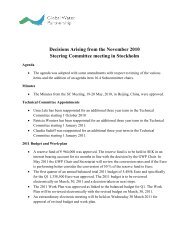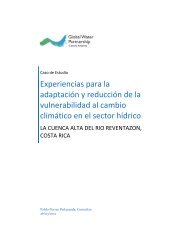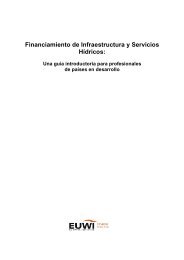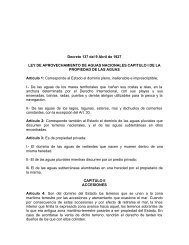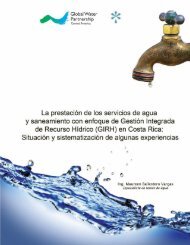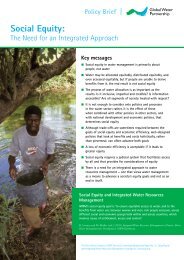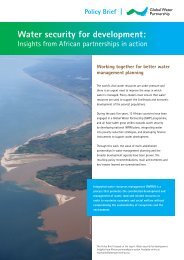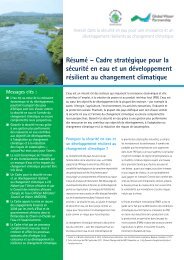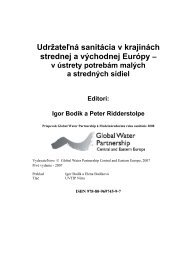Evaluation de la gouvernance de l'eau au Bénin ⢠Analyse de la ...
Evaluation de la gouvernance de l'eau au Bénin ⢠Analyse de la ...
Evaluation de la gouvernance de l'eau au Bénin ⢠Analyse de la ...
You also want an ePaper? Increase the reach of your titles
YUMPU automatically turns print PDFs into web optimized ePapers that Google loves.
<strong>Evaluation</strong> <strong>de</strong> <strong>la</strong> <strong>gouvernance</strong> <strong>de</strong> l’e<strong>au</strong> <strong>au</strong> Bénin : analyse <strong>de</strong> <strong>la</strong> situation et actions prioritairesCOORDINATION EFFICACITE OBSTACLES CONSEQUENCES DU MANQUE DE GESTIONCoordinationl’agricultureavecDescriptionsuccincte dumécanismeJustification <strong>de</strong>sinsuffisances s’il enexisteActions proposéesLe mécanismefonctionne bienLe mécanisme estutilisé mais nonéquitableMécanismepresque pas utiliséPas <strong>de</strong> mécanismeen p<strong>la</strong>ceLes différentsintérêts nonéquilibrésNombre <strong>de</strong>personnesaffectéesToute <strong>la</strong> popu<strong>la</strong>tionPas <strong>de</strong> suivi Effets Conflits d’attribution,Duplication <strong>de</strong>s rôles,Erosion due <strong>au</strong>x pratiques culturalesPollution chimique <strong>de</strong> l’e<strong>au</strong>Nul n’est informé<strong>de</strong> son existencePas encore prêtDurée Immédiat Long terme irréversibilitéCoûtestimatif /DommagesIl n’existe pas <strong>de</strong> structure <strong>de</strong> concertation/coordination.Distribution <strong>de</strong>s mandats <strong>de</strong>s services <strong>de</strong> l’Etat : ressemb<strong>la</strong>nt plus à une juxtaposition <strong>de</strong> champs <strong>de</strong> compétencesconcurrents qu’à une répartition rationnelle <strong>de</strong> missions complémentaires et coordonnées.Participation <strong>de</strong>s acteurs, se faisant <strong>de</strong> façon plus ou moins informelle : inexistence d’instance nationale offrant uncadre formel à <strong>la</strong> participation <strong>de</strong>s parties prenantes <strong>au</strong> processus <strong>de</strong> prise <strong>de</strong> décision.Politiques agricoles n’intègrent pas suffisamment <strong>la</strong> protection <strong>de</strong>s ressources hydriquesCréation du cadre <strong>de</strong> concertation <strong>de</strong>s différents acteurs.Profon<strong>de</strong> réforme du cadre institutionnel : harmonisation avec les principes <strong>de</strong> <strong>la</strong> bonne <strong>gouvernance</strong> <strong>de</strong> l’e<strong>au</strong> et avecles gran<strong>de</strong>s orientations <strong>de</strong> <strong>la</strong> politique <strong>de</strong> décentralisation/déconcentration.Etablissement d’un véritable dialogue entre les différentes institutions intervenant dans le secteur <strong>de</strong> l’e<strong>au</strong>.COORDINATION EFFICACITE OBSTACLES CONSEQUENCES DU MANQUE DE GESTIONCOORDINATIONAVECL’AGRICULTUREDescriptionsuccincte dumécanismeJustification <strong>de</strong>sinsuffisances s’il enexisteActions proposéesLe mécanismefonctionne bienLe mécanisme estutilisé mais nonéquitableMécanismepresque pas utiliséPas <strong>de</strong> mécanismeen p<strong>la</strong>ceLes différentsintérêts nonéquilibrésNombre <strong>de</strong>personnesaffectéesToute <strong>la</strong> popu<strong>la</strong>tionPas <strong>de</strong> suivi Effets Conflits d’attribution,Duplication <strong>de</strong>s rôles,Erosion due <strong>au</strong>x pratiques culturalesPollution chimique <strong>de</strong> l’e<strong>au</strong>Nul n’est informé<strong>de</strong> son existencePas encore prêtDurée Immédiat Long terme irréversibilitéCoûtestimatif /DommagesIl n’existe pas <strong>de</strong> structure <strong>de</strong> concertation/coordination.Distribution <strong>de</strong>s mandats <strong>de</strong>s services <strong>de</strong> l’Etat : ressemb<strong>la</strong>nt plus à une juxtaposition <strong>de</strong> champs <strong>de</strong> compétencesconcurrents qu’à une répartition rationnelle <strong>de</strong> missions complémentaires et coordonnées.Participation <strong>de</strong>s acteurs, se faisant <strong>de</strong> façon plus ou moins informelle : inexistence d’instance nationale offrant uncadre formel à <strong>la</strong> participation <strong>de</strong>s parties prenantes <strong>au</strong> processus <strong>de</strong> prise <strong>de</strong> décision.Politiques agricoles n’intègrent pas suffisamment <strong>la</strong> protection <strong>de</strong>s ressources hydriquesCréation du cadre <strong>de</strong> concertation <strong>de</strong>s différents acteurs.Profon<strong>de</strong> réforme du cadre institutionnel : harmonisation avec les principes <strong>de</strong> <strong>la</strong> bonne <strong>gouvernance</strong> <strong>de</strong> l’e<strong>au</strong> et avecles gran<strong>de</strong>s orientations <strong>de</strong> <strong>la</strong> politique <strong>de</strong> décentralisation/déconcentration.Etablissement d’un véritable dialogue entre les différentes institutions intervenant dans le secteur <strong>de</strong> l’e<strong>au</strong>.42


